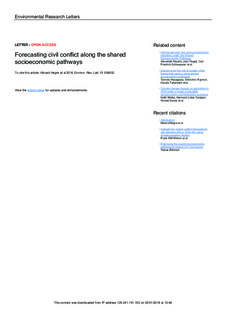| dc.contributor.author | Hegre, Håvard | |
| dc.contributor.author | Buhaug, Halvard | |
| dc.contributor.author | Calvin, Katherine V. | |
| dc.contributor.author | Nordkvelle, Jonas | |
| dc.contributor.author | Waldhoff, Stephanie T. | |
| dc.contributor.author | Gilmore, Elisabeth | |
| dc.date.accessioned | 2018-01-03T09:03:05Z | |
| dc.date.available | 2018-01-03T09:03:05Z | |
| dc.date.created | 2016-07-20T11:18:59Z | |
| dc.date.issued | 2016 | |
| dc.identifier.citation | Environmental Research Letters. 2016, 11. | nb_NO |
| dc.identifier.issn | 1748-9326 | |
| dc.identifier.uri | http://hdl.handle.net/11250/2474232 | |
| dc.description.abstract | Climate change and armed civil conflict are both linked to socioeconomic development, although conditions that facilitate peace may not necessarily facilitate mitigation and adaptation to climate change. While economic growth lowers the risk of conflict, it is generally associated with increased greenhouse gas emissions and costs of climate mitigation policies. This study investigates the links between growth, climate change, and conflict by simulating future civil conflict using new scenario data for five alternative socioeconomic pathways with different mitigation and adaptation assumptions, known as the shared socioeconomic pathways (SSPs). We develop a statistical model of the historical effect of key socioeconomic variables on country-specific conflict incidence, 1960–2013. We then forecast the annual incidence of conflict, 2014–2100, along the five SSPs. We find that SSPs with high investments in broad societal development are associated with the largest reduction in conflict risk. This is most pronounced for the least developed countries—poverty alleviation and human capital investments in poor countries are much more effective instruments to attain global peace and stability than further improvements to wealthier economies. Moreover, the SSP that describes a sustainability pathway, which poses the lowest climate change challenges, is as conducive to global peace as the conventional development pathway. | nb_NO |
| dc.language.iso | eng | nb_NO |
| dc.publisher | IOP Publishing | nb_NO |
| dc.rights | Navngivelse 4.0 Internasjonal | * |
| dc.rights.uri | http://creativecommons.org/licenses/by/4.0/deed.no | * |
| dc.title | Forecasting civil conflict along the shared socioeconomic pathways | nb_NO |
| dc.type | Journal article | nb_NO |
| dc.type | Peer reviewed | nb_NO |
| dc.description.version | publishedVersion | nb_NO |
| dc.source.volume | 11 | nb_NO |
| dc.source.journal | Environmental Research Letters | nb_NO |
| dc.source.issue | 5 | nb_NO |
| dc.identifier.doi | 10.1088/1748-9326/11/5/054002 | |
| dc.identifier.cristin | 1368726 | |
| dc.relation.project | Norges forskningsråd: 217995 | nb_NO |
| dc.description.localcode | © 2016 IOP Publishing Ltd. Original content from this work may be used under the terms of the Creative Commons Attribution 3.0 licence. | nb_NO |
| cristin.unitcode | 194,67,25,0 | |
| cristin.unitname | Institutt for sosiologi og statsvitenskap | |
| cristin.ispublished | true | |
| cristin.fulltext | original | |
| cristin.qualitycode | 1 | |

